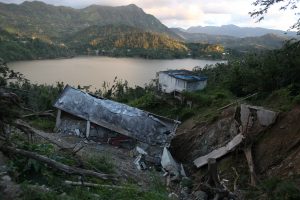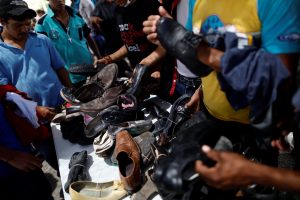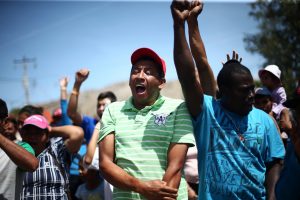
By Nick Brown
CANOVANAS, Puerto Rico (Reuters) – Among the countless Puerto Rico neighborhoods battered by Hurricane Maria is one named after another storm: Villa Hugo. The illegal shantytown emerged on a public wetland after 1989’s Hurricane Hugo left thousands homeless.
About 6,000 squatters landed here, near the El Yunque National Forest, and built makeshift homes on 40 acres that span a low-lying valley and its adjacent mountainside. Wood and concrete dwellings, their facades scrawled with invented addresses, sit on cinder blocks. After Maria, many are missing roofs; some have collapsed altogether.
Amid the rubble, 59-year-old Joe Quirindongo sat in the sun one recent day on a wooden platform – the only remaining piece of his home. Soft-spoken with weathered skin and a buzzcut, Quirindongo pondered his limited options.
“I know this isn’t a good place for a house,” said Quirindongo, who survives on U.S. government assistance. “Sometimes I would like to go to another place, but I can’t afford anything.”
Villa Hugo reflects a much larger crisis in this impoverished U.S. territory, where so-called “informal” homes are estimated to house about half the population of 3.4 million. Some residents built on land they never owned. Others illegally subdivided properties, often so family members could build on their lots.
Most have no title to their homes, which are constructed without permits and usually not up to building codes. The houses range in quality and size, from one-room shacks to sizable family homes. Many have plumbing and power, though not always through official means.
The concentration of illegal housing presents a vexing dilemma for local and federal authorities already overwhelmed by the task of rebuilding an economically depressed island after its worst natural disaster in nine decades.
Puerto Rico Governor Ricardo Rosselló has stressed the need to “build back better,” a sentiment echoed by U.S. disaster relief and housing officials. But rebuilding to modern standards or relocating squatters to new homes would take an investment far beyond reimbursing residents for lost property value. It’s an outlay Puerto Rico’s government says it can’t afford, and which U.S. officials say is beyond the scope of their funding and mission.
Yet the alternative – as Villa Hugo shows – is to encourage rebuilding of the kind of substandard housing that made the island so vulnerable to Maria in the first place.
“It’s definitely a housing crisis,” said Fernando Gil, Puerto Rico’s housing secretary. “It was already out there before, and the hurricane exacerbates it.”
In Puerto Rico, housing is by far the largest category of storm destruction, estimated by the island government at about $37 billion, with only a small portion covered by insurance. That’s more than twice the government’s estimate for catastrophic electric grid damage, which was made far worse by the shoddy state of utility infrastructure before the storm.
Puerto Rico officials did not respond to questions about how the territory estimated the damage to illegally built homes.
Maria destroyed or significantly damaged more than a third of about 1.2 million occupied homes on the island, the government estimates. Most of those victims had no hazard insurance – which is only required for mortgage-holders in Puerto Rico – and no flood insurance. Just 344,000 homes on the island have mortgages, according U.S. Census Bureau data.
Officials at the U.S. Federal Emergency Management Agency (FEMA) and the Small Business Administration (SBA) acknowledged the unique challenges of delivering critical housing aid to Puerto Rico. Among them: calculating the damage to illegal, often substandard homes; persuading storm victims to follow through on application processes that have frustrated many into giving up; and allocating billions in disaster aid that still won’t be nearly enough solve the island’s housing crisis.
By far the most money for Puerto Rico housing aid is expected to come from the U.S. Department of Housing and Urban Development (HUD).
HUD spokeswoman Caitlin Thompson declined to comment on how the agency would spend billions of dollars in disaster relief funds to rebuild housing, or how it planned to help owners of informally built homes. Two HUD officials overseeing the agency’s Puerto Rico relief efforts, Todd Richardson and Stan Gimont, also declined to comment.
But the disaster aid package currently under consideration by the U.S. Congress would provide far less housing aid than Puerto Rico officials say they need. Governor Rosselló is seeking $46 billion in aid from HUD, an amount that dwarfs previous allocations for even the most destructive U.S. storms.
That’s nearly half the island’s total relief request of $94 billion.
The U.S. House of Representatives instead passed a package of $81 billion, with $26 billion for HUD, that still needs Senate and White House approval. The money would be divided between regions struck by several 2017 hurricanes – including Maria, Harvey in Texas and Irma in Florida – as well as the recent California wildfires. Congress could also decide to approve additional aid later.

FILE PHOTO – A house destroyed during Hurricane Maria in September 2017 is seen in Utuado, Puerto Rico February 1, 2018. REUTERS/Alvin Baez
‘MY MOTHER IS SCARED’
A generation ago, Maria Vega Lastra, now 61, was among the estimated 28,000 people displaced by Hurricane Hugo. Neighbors helped her build a new home in what would become Villa Hugo, in the town of Canóvanas.
Her daughter, 34-year-old Amadaliz Diaz, still recalls her older brother grinning as he sawed wood for the frame of their self-built, one-floor house, with a porch and three bedrooms.
Now, Vega Lastra’s roof has holes in it, and her waterlogged wooden floorboards buckle with each step.
Vega Lastra has been staying with her daughter, who lives in Tampa, as the family waits on applications for FEMA aid. The agency initially denied her application in December, saying it could not contact her by phone, Diaz said.
Vega Lastra is returning to her home this week, uncertain if its condition has gotten worse. Her daughter bought her an air mattress to take with her.
“My mother is scared,” Diaz said. “I hope the government helps her. I work, but I have three kids to take care of.”
The island’s housing crisis long predated the storm. According to Federal Housing Finance Agency data, Puerto Rico’s index of new home prices fell 25 percent over the last decade, amid a severe recession that culminated last May in the largest government bankruptcy filing in U.S. history.
Legal home construction, meanwhile, plummeted from nearly 16,000 new units in 2004 to less than 2,500 last year, according to consultancy Estudios Tecnicos, an economic data firm.
A 2007 study by environmental consultant Interviron Services Inc, commissioned by the Puerto Rico Builders Association, found that 55 percent of residential and commercial construction was informal. That would work out to nearly 700,000 homes.
That figure might be high, said David Carrasquillo, president of the Puerto Rico Planning Society, a trade group representing community planners. But even a “very conservative” estimate would yield at least 260,000 illegally built houses, he said.
Generations of Puerto Rican governments never made serious efforts to enforce building codes to stop new illegal housing, current and former island officials said in interviews. Past administrations had little political or economic incentive to force people out of neighborhoods like Villa Hugo.
Former Governor Rafael Hernandez Colon, in office during Hurricane Hugo, said he tried to help informal homeowners without policing them. “Our policy was not to relocate, but rather improve those places,” Hernandez Colon said in an interview.
Subsequent administrations advocated similar policies; none made meaningful headway, partly because of Puerto Rico’s constant political turnover.
Today, informal communities provide a stark contrast to San Juan’s glittering resorts and bustling business districts. San Juan Mayor Carmen Yulin Cruz pointed to poor barrios like those near the city’s Martín Peña Channel, hidden behind the skyscrapers of the financial hub known as the Golden Mile.
“It’s not something I’m proud of, but we hide our poverty here,” Cruz said in an interview.
RECOVERY DILEMMA
The task of rebuilding Puerto Rico’s housing stock ultimately falls to the territory government, which has no ability to pay for it after racking up $120 billion in bond and pension debt in the years before the storm.
That leaves the island dependent on U.S. relief from FEMA, the SBA and HUD.
The SBA offers low-interest home repair loans of up to $200,000. FEMA provides homeowners with emergency grants, relocation assistance and other help. HUD is focused on long-term rebuilding efforts, working directly with local agencies to subsidize reconstruction through grants.
FEMA’s cap for disaster aid to individuals is $33,300, and actual awards are often much lower. Normally, FEMA eligibility for housing aid requires proving property ownership, but the agency says it will help owners of informal homes if they can prove residency.
How exactly to help gets complicated. For example, someone who builds their own home with no permits on land they own is more likely to be treated as a homeowner, said Justo Hernandez, FEMA’s deputy federal coordinating officer. Squatters who built on land they didn’t own, however, would likely only be given money to cover lost items and relocate to a rental, he said.
Several Villa Hugo residents said they received money from FEMA, but many didn’t know what it was for and complained it wasn’t enough.
Lourdes Rios Romero, 59, plans to appeal the $6,000 grant she got for repairs to her flooded home, citing a much higher contractor’s quote. Neighbor Miguel Rosario Lopez, a 62-year-old retiree, showed a statement from FEMA saying he was eligible for $916.22, “to perform essential repairs that will allow you to live in your home.”
Without money for major changes, most homeowners said they planned to combine the aid they might get from FEMA with what little money they could raise to rebuild in the same spot.
FEMA does not police illegal building. Code enforcement is left to the same local authorities who have allowed illegal construction to persist for years.
Quirindongo is planning to buy materials to rebuild his Villa Hugo home himself with about $4,000 from FEMA. It will be the third time he has done so, having lost one home to a 2011 flood, another to a fire.
“I just want to have something that I can say, ‘This is mine,’” Quirindongo said.
GIVING UP
Many others appear to have given up on FEMA aid because the agency’s application process is entangled with a separate process for awarding SBA loans to rebuild homes.
FEMA is legally bound to assess whether applicants might qualify for SBA loans before awarding them FEMA grants. If an applicant passes FEMA’s cursory eligibility assessment, they are automatically referred to SBA for a more thorough screening.
Applicants are not required to follow through on the SBA process – but they cannot qualify for FEMA aid unless they do. FEMA only provides a grant when the SBA denies the applicant a loan.
FEMA said it has referred about 520,000 people out of 1.1 million total applicants so far to the SBA. But as of Monday, only 59,000 followed through with SBA applications. Of those, some 12,000 later withdrew, SBA data shows.
“As soon as people see SBA they say, ‘I give up, I don’t want a loan – I can’t afford a loan,’” FEMA’s Hernandez said.
SBA spokeswoman Carol Chastang said the agency is working with FEMA to educate flood victims on available benefits and the application process, including sending staffers to applicants’ homes.
330,000 VACANT HOMES
Before the storm hit, Puerto Rico already had about 330,000 vacant homes, according to Census Bureau 2016 estimates, resulting from years of population decline as citizens migrated to the mainland United States and elsewhere. Puerto Ricans are American citizens and can move to the mainland at will.
Puerto Rico and federal officials have considered rehabilitating the vacant housing for short- and long-term use, along with building new homes and buying out homeowners in illegally built neighborhoods, according to Gil and federal officials.
Rosselló, the Puerto Rican governor, has said the rebuilding plan must include a fleet of properly built new homes. Gil, the housing secretary, said the administration would like to build as many as 70,000 properties.
HUD officials declined to comment on whether the agency would finance new housing. Its Community Development Block Grant program allows for local governments to design their own solutions and seek HUD approval for funding.
The cost of constructing enough new, code-compliant properties to house people displaced by Maria could far exceed the available federal aid. Making them affordable also presents a problem.
Puerto Rico’s subsidized “social interest housing,” geared toward low-income buyers, typically provides units that sell in the mid-$100,000 range, with prices capped by the government. That’s beyond the means of many displaced storm victims.
Gil offered little detail on a solution beyond saying it will include a mix of new development, buyout programs for owners of illegally built homes and other options.
The answer will come down to how much Washington is willing to pay, he said. He invoked the island’s territorial status and colonial history as a root cause of its poor infrastructure and housing stock before the storm.
“It is precisely because we have been neglected by the federal government that the island’s infrastructure is so weak,” he said.
Many Puerto Rico officials continue to advocate for bringing relief and legitimacy to squatter communities like Villa Hugo, rather than trying to relocate their residents.
Canovanas Mayor Lornna Soto has been negotiating with island officials to provide property titles to Villa Hugo’s population. The vast majority still don’t have them.
“It’s long overdue to recognize that they are not going anywhere and their communities need to be rebuilt with proper services,” Soto said.
Diaz said she supports her mother’s decision to return to Villa Hugo, regardless of what aid the government ultimately provides.
“I grew up there,” Diaz said. “Everyone knows us there.”
(Reporting by Nick Brown in Canóvanas, Puerto Rico; editing by Brian Thevenot)











